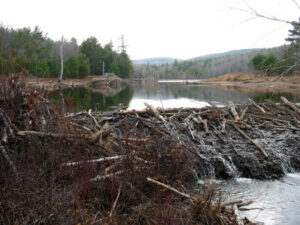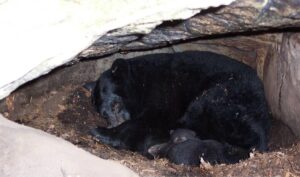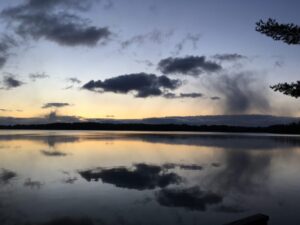November in New England is usually the time when we start to settle into the season as winter gets closer. Thanksgiving often marks the unofficial switch to a winter mentality. Gathering with loved ones over a meal and sharing stories, what you’re grateful for, and filling up on turkey and stuffing. In Naturally Curious: A Photographic Field Guide and Month-by-Month Journey Through the Fields, Woods, and Marshes of New England by Mary Holland, November is described by the word quiescence, meaning inactivity or dormancy. Like how many of us may feel after a filling Thanksgiving dinner.
New England temperatures can fluctuate greatly in November. Within a given state, climate conditions can be wildly erratic. First snows may fall in northern New England, yet balmy days are not unheard of. Throughout the Northeast most deciduous trees have lost their leaves and many animals have disappeared from sight. Reptiles and amphibians that didn’t enter hibernation last month do so in November. Insect sightings become more and more scarce. The last of the migrant birds are leaving. Mammals that don’t remain active through the winter have entered hibernation or dormancy. The natural world is bracing for winter.
This time of year may make you think about what reptiles and amphibians are doing. Often, they are hibernating already at this point. The Northern Leopard Frog retreats to mud at the bottom of ponds and streams for the winter. They lay dormant; however, they do not freeze like the spring peeper or wood frog. As for reptiles, we also observe hibernation. The cooler temperatures make it difficult for northern snakes to stay active in the winter. If these cold-blooded creatures cannot produce their own body heat, then what do they do in the winter? The North American Racer migrates up forested slopes to communal dens, often in deep rock crevices on southeast facing slopes to get as much warmth from the sun as possible. North American Racers will spend the time before hibernating soaking up as much sunlight as possible before entering the den to overwinter. They have been known to share the den with other species of snakes in their range.
Many of the migratory birds of New England have moved to wintering grounds, and birds such as the White-Crowned Sparrow of the Canadian tundra can be seen passing through New England on their way to their wintering grounds, which can be as far north as southern Connecticut. For the porcupine, white-tailed deer, moose, snowshoe hare, and cottontail rabbit there is less abundance of food so they must adapt to a new diet for the winter months. Instead of feeding on the abundant herbs of the summer, herbivores must shift foods like woody vegetation, acorns and nuts, tree bark, and twigs. Much less appetizing, but necessary for survival. Mice and Beavers who have nests or lodges respectively don’t need to resort to eating less desirable foods for the winter because they can stockpile food for the winter. Beavers can eat two pounds of bark a day, and a lodge can house up to ten beavers at a time, so having a supply of food is important. The White-Footed Deermouse and the North American Deermouse will store berries, nuts, and seeds to sustain them throughout the winter. For the American Black Bear, storing food looks a little different. Earlier in the Autumn they stuff their face to increase their weight to as much as 100% of their bodyweight. Once the temperatures start to dip and the food supply dwindles, Black Bears climb into their den and remain dormant until spring brings warmer weather. Black bears drop their body temperature slightly below normal and slow their metabolism. While in their dens bears do not defecate or urinate. Black Bears usually choose dens under stumps, logs, brush piles, or holes, using leaves, twigs, and woodchips as bedding.
In the New England Forests, leaves have mostly fallen off the trees, except for some young beech and oak trees, who retain their leaves into the winter. Birds’ nests, now abandoned, are exposed and reveal the interesting structures each species builds. Thrifty birds have built nests out of materials scattered around the forest floor, or neighborhood. Sometimes picking up human-made objects and using them to build a nest.
As things quiet down it may be more difficult to notice the life around you, but take the time to notice the quiet, subtle things happening. Take a note from the forest and begin to adjust to the season. Feel the energy shift, make your own den comfortable, plan some recipes to prepare for cooler nights, and connect with friends and family. Settle into it and keep your awareness up to continue your phenological study.





